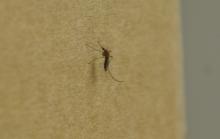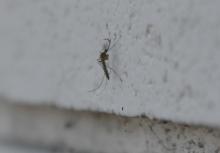Culicidae
Pest description and damage Mosquitoes can be an irritating nuisance and can transmit certain diseases to humans and animals through blood feeding. Female mosquitoes must obtain a blood meal in order to lay eggs. Eggs are laid in still waters (ponds or containers), and therefore control efforts should be directed at these places. Good water management practices (breeding source reduction) can reduce mosquitoes significantly.
Biological control of mosquitoes using Gambusia affinis, a top minnow that feeds on mosquito larvae, has proven successful in many log ponds and other permanent bodies of water. However, use of gambusia is not permitted in all states, so consult the appropriate state Fish and Game agency before considering introducing them.
Bacillus thuringiensis var. israelensis (Bti) is a biologically derived insecticide for mosquito control. It is an endospore-forming bacterium, which larvae must ingest. Bti is most effective on young larvae. Effectiveness is reduced in waters with high organic content.
Use conventional insecticides only after taking steps at source reduction and biological control. Because mosquitoes breed only at the edges of large bodies of water, treatment can be confined to these edges.
Management
Preventing mosquito bites
Avoiding mosquito bites is the best way to prevent disease transmission. Avoid being outside during periods of high mosquito activity, particularly around dawn and dusk. When exposure to mosquitoes is unavoidable, wear a light-color, long-sleeve shirt and long pants, and apply an effective insect repellent with proven compounds, such as DEET (N, N-diethyl-m-toluamide) or oil of lemongrass. During warm periods, windows and doors should be protected by intact screens or out-facing fans to prevent mosquitoes from entering the house.
Reduce breeding sites around homes and other structures. Look for areas that collect or hold standing water over extended periods. These may include clogged gutters, low spots in the yard or landscape, wheelbarrows, buckets, discarded tires, tarps or any other object that can hold more than a tablespoon of water. Removing standing water discourages mosquito production by eliminating breeding sites. Bird baths and water troughs should be cleaned and water replaced every 12 to 14 days. Where water cannot be removed, larvicides should be considered.
Pesticides for mosquito control
Pesticides used in mosquito control are designated as either adulticides or larvicides. Adulticides are used to control flying mosquitoes, while larvicides are applied to water and kill immature mosquitoes. Larvicides include insect growth regulators, bacteria (e.g., Bacillus thuringiensis var. israelensis), and oils which have low toxicities to mammals and other non-target organisms. Adulticides require contact with the insect and can provide a temporary reduction in pest numbers. Only materials specifically registered for mosquito control should be used.
Mosquito control and municipal organizations
Mosquito control is most effective when done over a relatively large area. Therefore, control efforts are often organized by forming mosquito abatement or vector control districts. The first step in organizing a formal program of mosquito control is to establish the severity of the problem and identify potential breeding sites. In the Pacific Northwest, the Northwest Mosquito and Vector Control Association is a source of information on local vector control problems.



